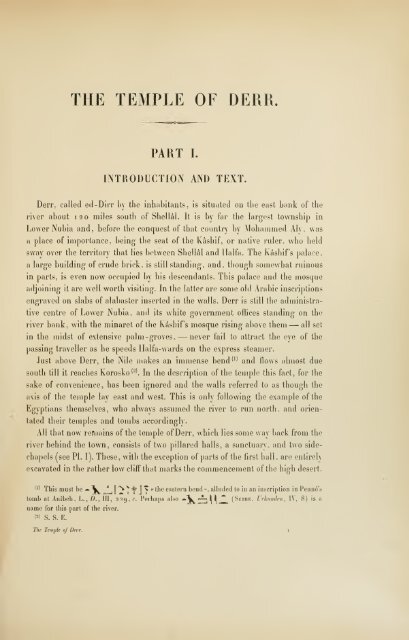The Temple of Derr
The Temple of Derr
The Temple of Derr
Create successful ePaper yourself
Turn your PDF publications into a flip-book with our unique Google optimized e-Paper software.
THE TEMPLE OF DERR<br />
PART I.<br />
INTRODUCTION AND TEXT.<br />
<strong>Derr</strong>. called ed-Dirr b\ the inhabitants, is situated on the east bank <strong>of</strong> the<br />
river about 190 miles south <strong>of</strong> Shellal. It is by far the largest township in<br />
Lower Nubia and, before the conquest <strong>of</strong> that country by Mohammed Alv. was<br />
a place <strong>of</strong> importance, being the seat <strong>of</strong> the Kashif, or native ruler, who held<br />
sway over the territory that lies between Shellal and Haifa. <strong>The</strong> Kashifs palace,<br />
a large building <strong>of</strong> crude brick, is still standing, and. though somewhat ruinous<br />
in parts, is even now occupied by bis descendants. This palace and the mosque<br />
adjoining it are well worth visiting. In the latter are some old Arabic inscriptions<br />
engraved on slabs <strong>of</strong> alabaster inserted in the walls. <strong>Derr</strong> is still the administra-<br />
tive centre <strong>of</strong> Lower Nubia, and its white government <strong>of</strong>fices standing on the<br />
river bank, with the minaret <strong>of</strong> the KasluTs mosque rising above them — all set<br />
in the midst <strong>of</strong> extensive palm-groves. — never fail to attract the eye <strong>of</strong> the<br />
passing traveller as he speeds Haifa-wards on the express steamer.<br />
Just above <strong>Derr</strong>, the Nile makes an immense bend (1) and Hows almost due<br />
south till it reaches Korosko (<br />
'<br />
2)<br />
. In the description <strong>of</strong> the temple this fact, for the<br />
sake <strong>of</strong> convenience, has been ignored and the walls referred to as though the<br />
axis <strong>of</strong> the temple lay east and west. This is only following the example <strong>of</strong> the<br />
Egyptians themselves, who always assumed the river to run north, and orien-<br />
tated their temples and tombs accordingly.<br />
All that now remains <strong>of</strong> the temple <strong>of</strong> <strong>Derr</strong>, which lies some way back from the<br />
river behind the town, consists <strong>of</strong> two pillared halls, a sanctuary, and two side-<br />
chapels (see PL I). <strong>The</strong>se, with the exception <strong>of</strong> parts <strong>of</strong> the first hall, are entirely<br />
excavated in the rather low cliff that marks the commencement <strong>of</strong> the high desert.<br />
l " This must be — V J^ ^ * ^ « | the ^ eastern bend -, alluded to in an inscription in Penny's<br />
J<br />
tomb at Anibcli. L, I)., \U, ato', c. Perhaps also (Sethb, Urkunien, IV. -^^J^ 8) is a<br />
name for this part <strong>of</strong> the river.<br />
'2 » S. S. E.<br />
<strong>The</strong> <strong>Temple</strong> <strong>of</strong> <strong>Derr</strong>. i

















